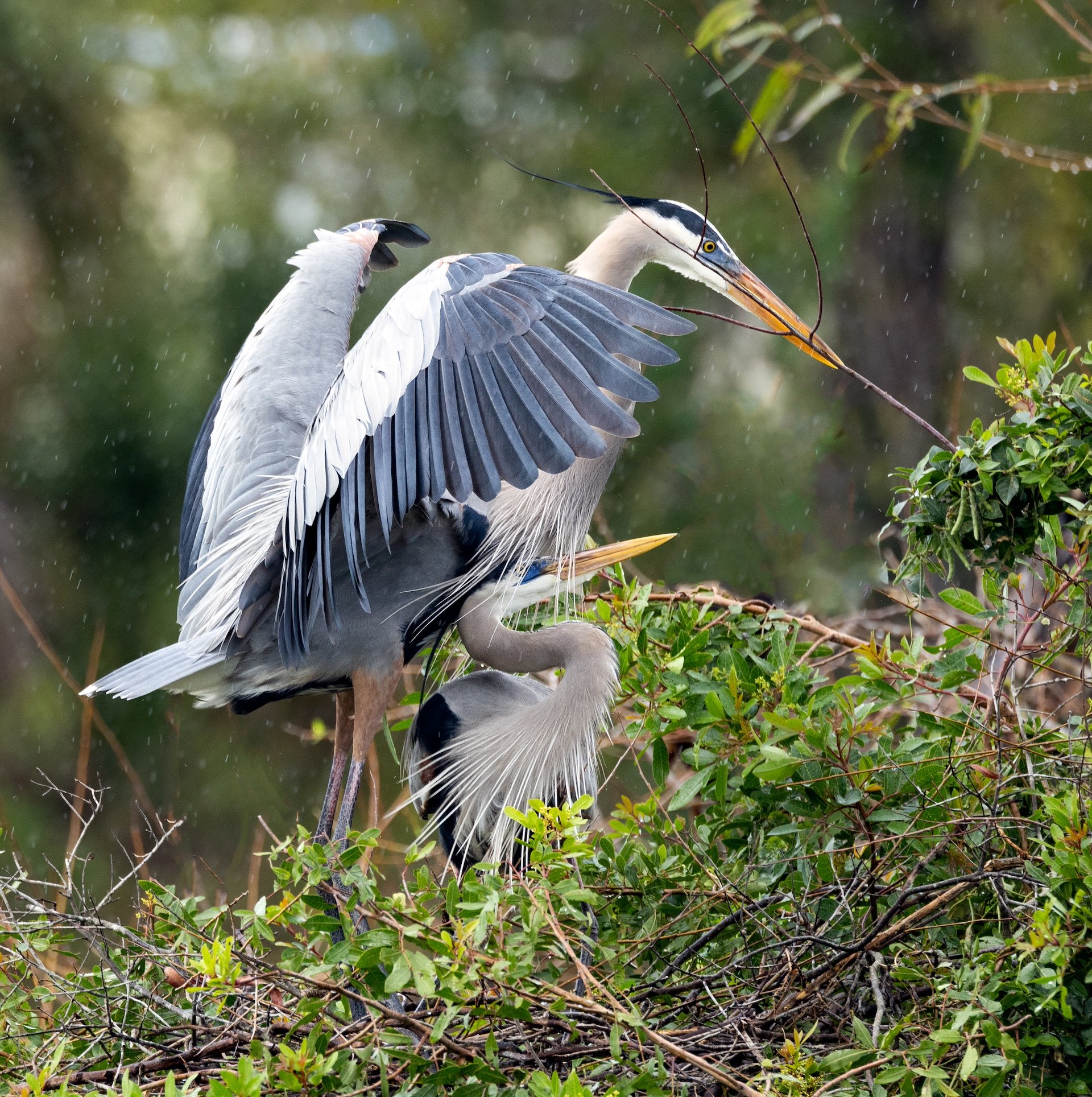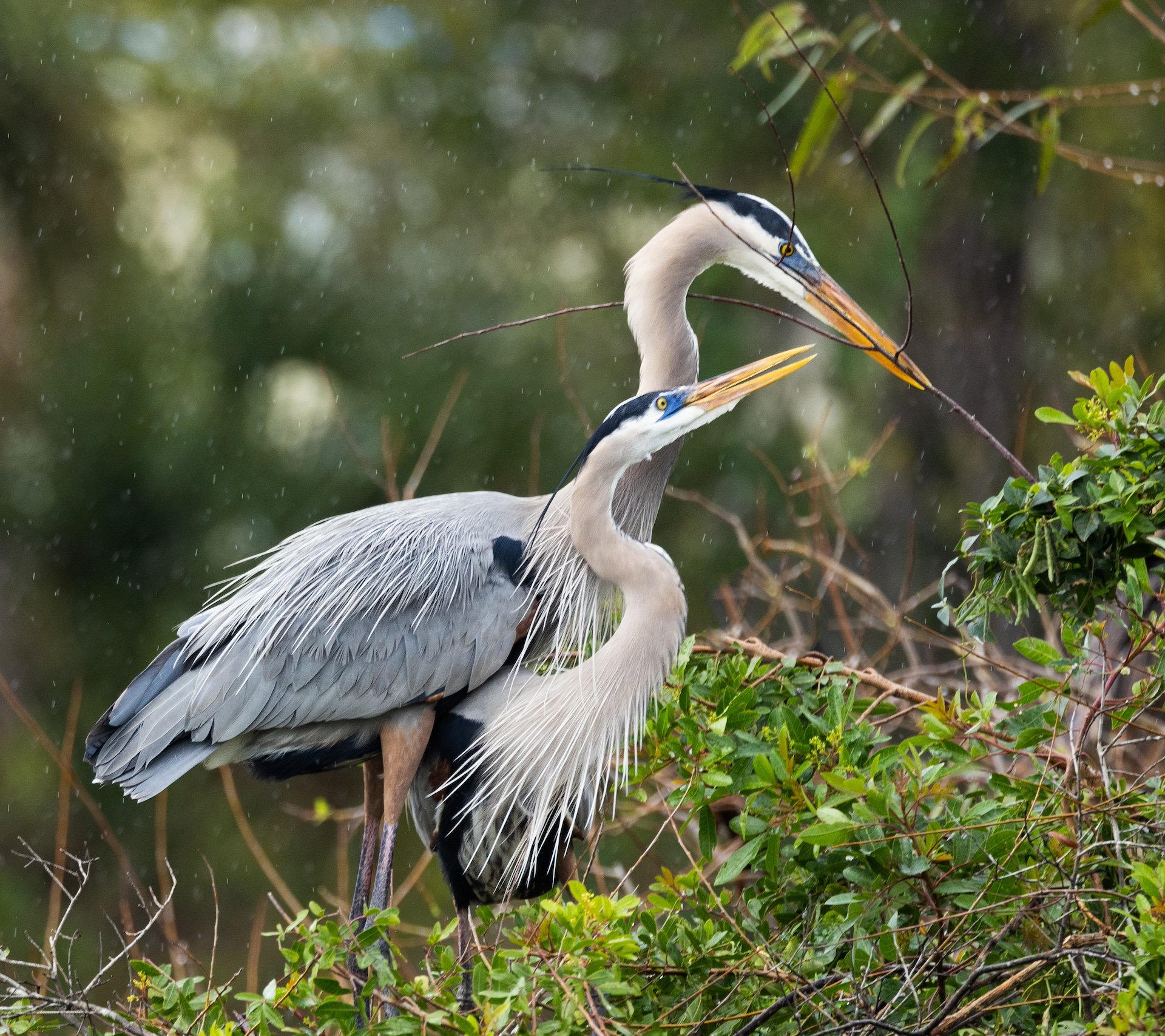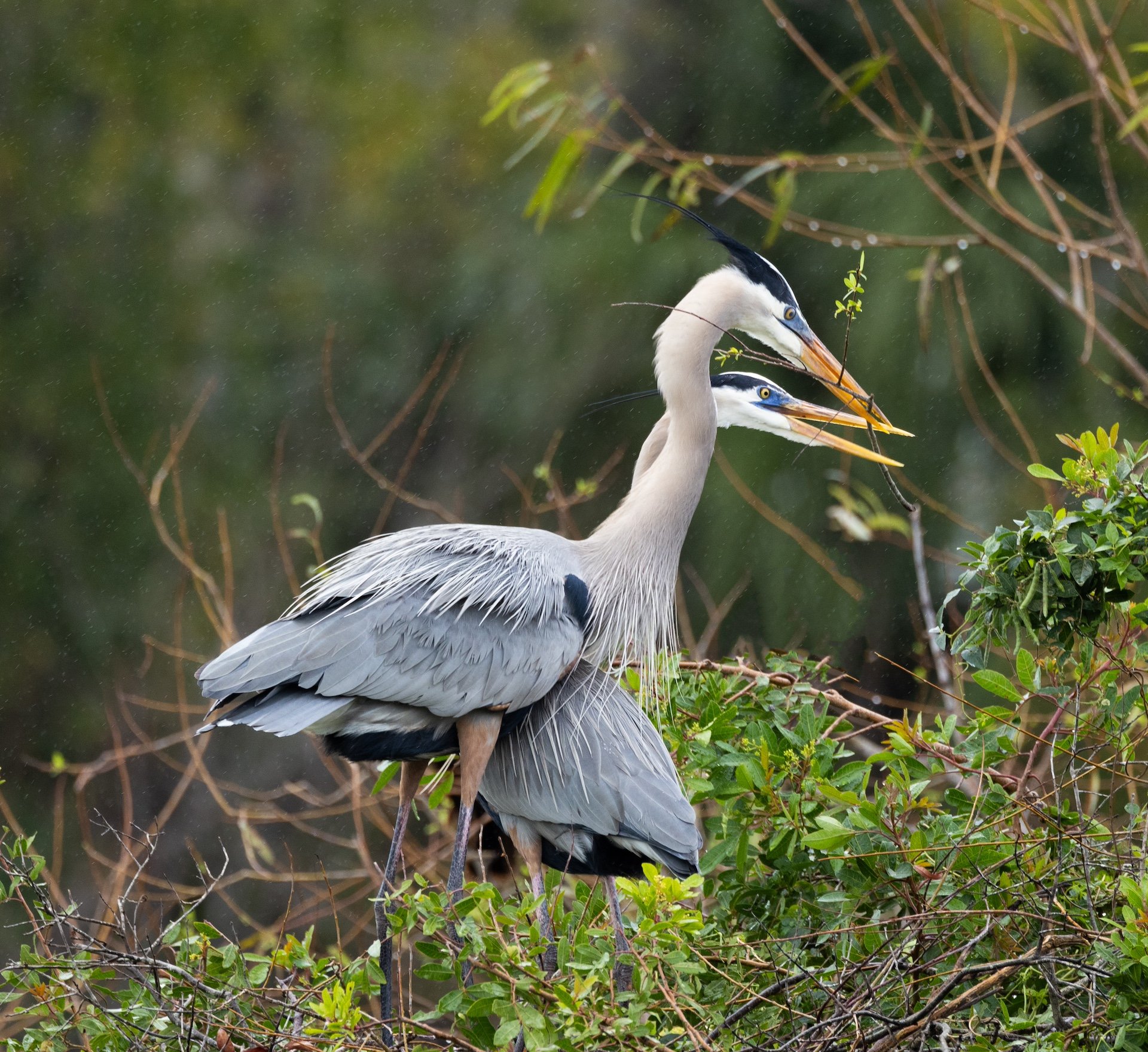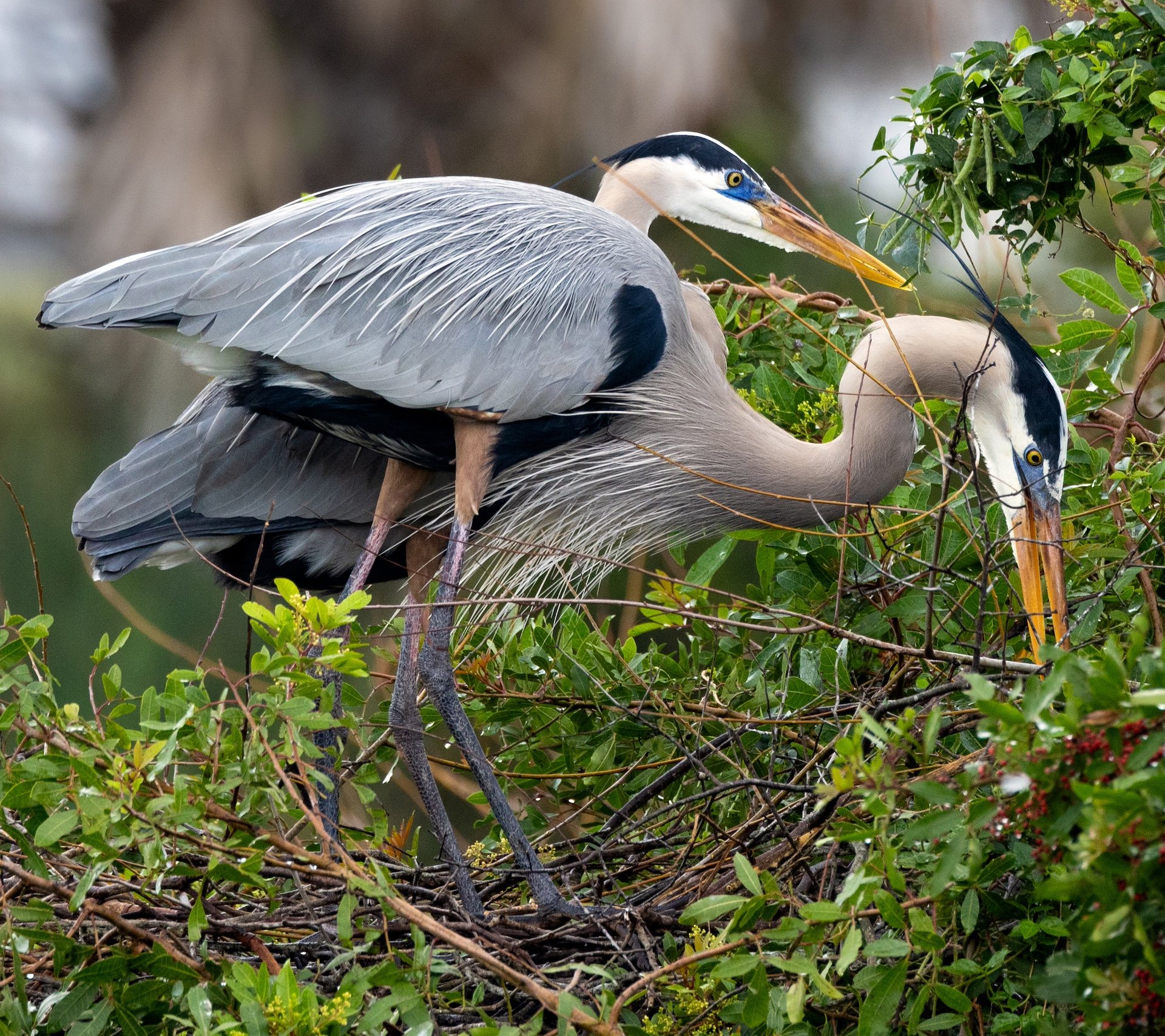Venice Area Audubon Rookery
Great Egrets standing on their nest
Amid urban development is an oasis of natural beauty that offers an unparalleled opportunity to closely observe a bird rookery island. During the winter months, great egrets, great blue herons, anhinga, cormorants, snowy egrets, and black crowned night herons (and more) perform the articulate, elaborate, and graceful courting postures and behaviors that offer a window into the pair bonding, nesting, and raising of chicks. From the edge of the pond, you can easily watch these immense birds fly back and forth collecting sticks for nests; witness the stunning display of feathers and colors from the great egret; observe the elegant great blue heron incubating her eggs; and enjoy the amazing posturing of the courting anhinga.
Great Egrets Building a Nest in the Rain
Driving into the Venice Area Audubon Rookery Park, you may question if you are in the right place as you pass businesses, parking lots, and the typical unattractive evidence of urban sprawl - but have faith. Once you park and walk over to the path along the rookery island, be prepared to be stunned and awed by the sheer number of birds roosting on the island and their seemingly complete oblivion (or acceptance) of the humans that are watching. Egrets will fly to the edge of the pond – just feet from you – to snap off branches for their nest; anhinga will be perched nearby in trees, and snowy egrets and black crowned night herons will be flanked on the edges. Around the pond you might also see blue-gray gnatcatchers, osprey, black-bellied whistling ducks, and common gallinule, among many others. As always, check eBird for the latest sightings.
Great Egrets joined by a stick for their nest
Highlights: The beauty of the great egrets during this time is truly magnificent and it is humbling and awe-inspiring to have the up-close opportunity to be immersed in their world for a brief time. At this vantage point, you can literally step into the habitat and life cycle of the great egret for a short period. From an hour or two of observation, you can learn so much from watching these great birds. Up until this point, I had only observed great egrets during non-breeding times and had not witnessed their intimate bonding, the tender moments of nest building and grooming, the transformation and choreographed display of aigrettes that grow from the shoulders during breeding and the deepening and changing of colors on the lore and beak.
Great Egret in breeding plumage
It is hard to imagine a world without such places that allow us to literally interact and connect with the nature world in such a tangible way. However, without the foresight of conservationists in the 1800s, great egrets would have been hunted to extinction for their aigrettes –then coveted feathers used for hats that fetched more money than gold. And without the conservationists of today, places like this rookery would cease to exist. Surely if we could transport people to such environments, I am convinced a deeper and more profound appreciation of wildlife would take place thereby leading to the development of an elevated ecological consciousness, and hopefully an understand of why we must preserve as much habitat as possible – not only for the birds, but for the gifts, lessons, beauty, and perspective that it provides to us.
Bird Photography: This is an ideal place to take photos of magnificent birds during courting, nesting, and raising chicks. Arrive near sunrise or sunset (this is important because the sun here is harsh and if it is too high, your shots may not have the contrast and depth you would like), bring a steady tripod and your zoom lens and set up with the sun at your back.
If you have two cameras, you can likely even snap some decent photos without a zoom, especially when the birds land right near you on the edge of the pond! Overall, you can’t miss taking amazing photos here even if you have a short period of time. But patience will reward you if you stay for a bit to capture the elaborate displays, the frequent flying, and the intimate and tender moments between their pairs.
And we went back! Great Egret with her three chicks
For more information and directions: https://www.veniceaudubon.org/rookery
Blue-Gray Gnatcatcher - on the side of the rookery.
Back and forth the Great Blue Heron flies from its nest to the trees along the edge of the pond. He stands at the edge, within the thicket of the thin limbed scrub trees and quietly, patiently looks for a twig to snap off and carry back to his nest. He jumps on the lower branches and uses his thick, powerful beak to test several twigs; several are seemingly unworthy of his nest, and he moves on, jumping further up the tree and testing more twigs until he finds a suitable selection. The Heron is careful, patient, and observant. He does not rush the process, does not lose focus, but evaluates each step and twig before moving on. He does not get frustrated and dismayed that that the process takes time. His goal is singular, and his focus is determined. After several tests, he finds the right twig, one that is sturdy and of an appropriate thickness to lay upon and weave into the nest. He snaps off the twig and repositions himself on the branch to fly back across the pond. He stretches his long, blue- gray wings, and launches into the air to take flight just over the water, twig in beak. When he begins his flight back, his mate, who has been standing at alert on their nest, calls to him, lifts her long neck and beak straight up to the sky. He lands on the nest, covering her body with his wings, and presents the twig. For a moment the two hold the twig together and then she takes the stick and adds it to their nest. Like her mate, she is careful in her placement and takes time to adjust the twig to the right spot. Together they observe their work and settle for a moment of stillness before he takes off across the pond again to repeat the process of selecting yet another perfect twig for their nest. This process repeats for days, sometimes weeks. I watched the Great Blue Herons perform this ritual in an afternoon that saw rain, sun, and clouds. Birds flew all around them in the rookery and traffic hummed in the background, but they remain focused on the task, on what needed to be done, without distraction. What a gift!










